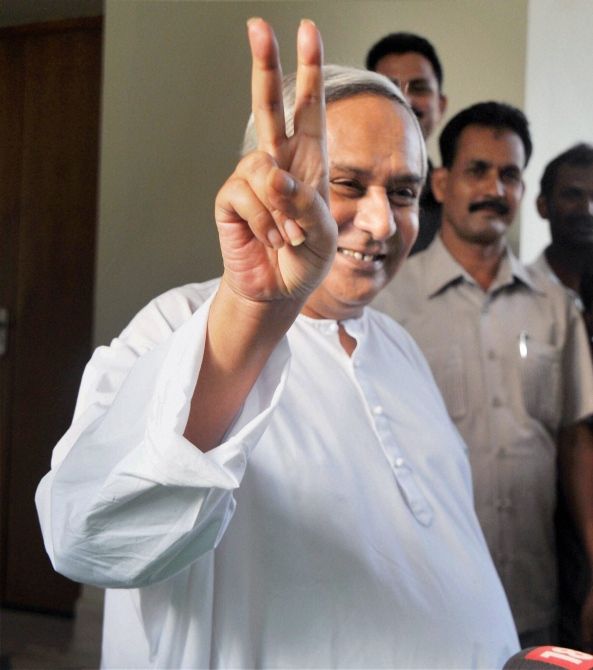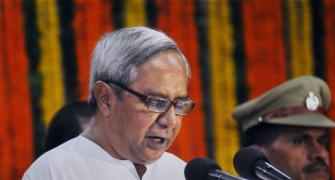 The 67-year-old Naveen Patnaik hasn’t only received a clear-cut mandate for an unprecedented fourth term but also done it on his own. From distributing tickets to planning party campaigns to chalking out strategies for the present and the future, the chief minister had played a stellar role throughout, and emerged successful in his endeavour, writes Bikash Mohapatra.
The 67-year-old Naveen Patnaik hasn’t only received a clear-cut mandate for an unprecedented fourth term but also done it on his own. From distributing tickets to planning party campaigns to chalking out strategies for the present and the future, the chief minister had played a stellar role throughout, and emerged successful in his endeavour, writes Bikash Mohapatra.
When Naveen Patnaik was sworn in as the chief minister of Odisha earlier this week, it was all about reassurances.
While in the first two terms winning came easy, it was also about appeasing everyone in what was a coalition government -- with the Bharatiya Janata Party. In the third, he benefited from severing ties with the same, thereby re-establishing his secular credentials in the aftermath of the 2008 Kandhamal riots.
Even though Patnaik won comfortably, it was anything but smooth sailing thereafter. Accusations of rampant corruption in his party, a failed coup attempt, a series of scams -- illegal mining, chit fund scandals and charges of irregularities in rural job scheme (Mahatma Gandhi National Rural Employment Gurantee Act) -- had raised many questions about the credibility of the government and made his third term the most turbulent period.
So this election it was different. The fact that nothing could stop the chief minister from leading the Biju Janata Dal to a landslide victory in both the assembly and Lok Sabha polls, the party winning 117 out of 147 seats in the assembly and 20 out of 21 Lok Sabha seats -- a considerable increase from 2009 (14 Lok Sabha seats and 103 in the assembly), has come in as a confidence booster.
The 67-year-old hasn’t only received a clear-cut mandate for an unprecedented fourth term but also done it on his own. From distributing tickets to planning party campaigns to chalking out strategies for the present and the future, the chief minister had played a stellar role throughout, and emerged successful in his endeavour.
“It (Naveen’s win) was both expected and unexpected,” said eminent analyst Prof Biswaranjan Mahapatra. “Everyone was aware that Naveen Patnaik will come back to power but what was unexpected was the number of seats the (BJD) won.”
“If you look at the state assembly, the eventual number (117 out of 147) was beyond all the expectations. Most of the analysts and theorists had expected the party to win about 75 to 80 seats,” he added, before proceeding to analyse the significance of the result.
“For 10 years, it was a coalition government. Naveen wasn’t free of tension,” explained Prof Mahapatra, adding, “In 2009, the BJD won by a landslide but the perception (till 2012) was that the chief minister was being remote-controlled by Pyari Mohan Mahapatra -- a retired bureaucrat who had political ambitions.”
“It’s only in the last year and half, after the attempted coup was negated and Pyari Mohan Mahapatra was sent to political wilderness, that the CM has heaved a sigh of relief. This election marks the first time it was entirely Naveen’s win.”
So what was it that worked in favour of Naveen and the BJD? Was it his personality or was it because of the fact that he is a master strategist and a pragmatist?
“The clear cut mandate was mainly because of two factors,” assessed Prof Mahapatra.
“Firstly, it was the many women-centric schemes -- the self-help groups, the ‘womb to tomb’ scheme (janani jashoda) and the Harishchandra scheme that provides funds to a family after the death of its head -- that worked wonders. For the record, more than 48 per cent of the voters this time were women.”
“Secondly, despite all the accusations against the ruling party, fact remains there is no coherent opposition. And with no alternative around, people went for status quo,” said the professor.
“The Congress is afflicted with lack of organisation and internal bickering. The BJP, on the other hand, hadn’t done any work at the organisational level and depended a lot on the Modi wave. Also, the fact remains during their 10 years in power (as coalition partners), the BJP members held important portfolios but did little work to convince the people of their worth.”
“Because of their own problems, the opposition could raise none of the issues in a manner that would have an impact on the mindset of people. And Naveen was smart enough to take advantage of this. In fact, weeks before the election, two key Congressmen -- opposition leader Bhupinder Singh and party secretary Anup Sai -- joined the ruling BJD, this having opposed the same party for the past 14 years,” said Mahapatra.
The state administration has had its share of woes during the tenure of the BJD, but the party, and the chief minister in particular, has emerged unscathed on every occasion.
In fact, the incumbents have improved their performance every time and a lot of credit for the same goes to their leader. What is it about Naveen that makes him a ‘teflon chief minister’?
“First, there’s still tremendous love and respect for Biju babu (former chief minister Biju Patnaik) and Naveen, being his son, benefits from that,” analysed Prof Mahapatra.
“Secondly, Naveen has managed to maintain his clean public image over the years. In the eyes of the people he is someone who has no personal interest, no family and nothing to lose as such,” he added.
Senior journalist Basanta Das concurred on the view above before explaining further. “If one critically analyses Naveen’s performance in the last 14 years, suffice to say the state has definitely progressed in fits and starts, but not in the manner it was expected to, considering it is resource rich,” he said, proceeding to validate his argument with numbers.
“Of the 92 MoUs (memorandum of understanding) signed with international firms during the period, which witnessed Odisha emerging as the biggest destination for foreign investment in India, few have made a smooth and fruitful progression. POSCO -- the single largest FDI initiative in India -- is yet to become a reality and the Mittals have cancelled their grand plans,” explained Das.
“Likewise, there were just two districts affected because of Maoist activities in 2000. That number has gone up to 18 now. The state government has failed to curb the Maoists. In fact, in two to three districts, there’s no administration apart from the Maoist rule.”
“However, the opposition, thanks to problems of their own, has failed to expose the inadequacies of the ruling party. The Modi wave that swept many parts of the country couldn’t make any headway in Odisha. The BJP was a non-starter,” said Das.
“In fact, Naveen scored well with the ‘step-motherly treatment’ rhetoric pertaining to the UPA government’s attitude towards the state.”
“Also on the positive side, his schemes for women and the people in rural areas (rice at Re1) won him many admirers. These are short-term programmes, targeted at different group of voters, but worked well because in the absence of an opposition, it provided people an incentive to opt for someone who could assure administration.”
“Besides, Naveen has successfully maintained his ‘clean’ image. The fact that he came down hard on some corrupt ministers in his cabinet as well as the dissenters created the impression that he doesn’t spare anyone. People (the common man) don’t like to go into the details of such things. They see what is there on the surface. And in Naveen they see a leader, sans any liability, who can serve them for a long time to come,” he concluded.
Image: Naveen Patnaik shows the victory sign after the party's victory in the Lok Sabha elections in Bhubaneswar on Friday.
Photograph: PTI Photo









